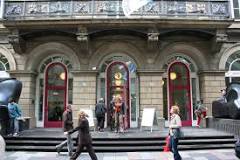You know how this old saying goes: Every cloud has a silver lining.
In this case, the silver lining has a cloud around it, if you can visualize it.
In April 2011, the plundered art blog publicized the presence of a painting by Caspar Netscher “Dame mit Papagei/Lady with a Parrot” at the Von der Heydt Museum in Wuppertal, Germany.
 |
| Von der Heide Museum, Wuppertal |
 |
| Lady with a Parrot |
Having no children, the Andriesse heirs named as their heirs local charities in New York City. To this day, some of these charities receive a monthly check for at least 700 dollars as ordered by the application of Mrs. Andriesse’s will.
In February 2015, the plundered art blog cited as an exception to the current German mindset of opposing restitution of Nazi looted art to rightful owners, the stance taken by the leadership of the Wuppertal Museum to return the Caspar Netscher painting to the heirs of the Andriesse family.
To be perfectly frank, I had undertaken in 2013 a series of discussions first indirectly then directly with that museum to find a way of doing the honorable thing—restitution. I was struck by the museum’s desire to be ethical and part ways with a gorgeous example of Netscher’s work in order to uphold the highest standards when it comes to resolving complex restitution issues that involve objects in the permanent collection of a museum.
In April 2015, a regular contributor to the plundered art blog reported on the TEFAF Maastrict Art Fair, an annual event bringing together the elite of the international art world. She noted the presence of the Caspar Netscher painting being offered for sale at a price higher than that fetched at Christie’s in June 2014, with very little indication of the painting’s troubled and exciting history.
Are there lessons to be drawn from this event?
On the plus side, the painting was identified, located, and restituted to the rightful heirs as designated in the Andriesse will. Much of this would not have happened without the benevolent research made public both on the ERR/Jeu de Paume database (since mid-October 2010!), on the plundered art blog and the intervention of a senior German museum official who helped bring to the von der Heydt Museum news about their painting being stolen property.
The down side of this story is the risk associated with making public information that might end up enriching unscrupulous members of the legal profession and others who make it their specialty to hunt for “treasure” disguised as art objects-expensive art objects-very expensive art objects which still need to be restituted and for which a claimant has been identified and the location of the unrestituted, claimable object revealed on public websites.
It’s an unfortunate trade off that I/we have agreed to in order to educate the public and make information about cultural plunder available to the masses as well as to a specialized audience.
The risk is that we provide the opportunity for some people with means and resources to make a significant amount of money for little to show for it at the expense of exploring more creative solutions to restitution which can benefit the great many of us. In the case of the Netscher painting, one scenario was for the painting to be placed on permanent loan at the museum by the fortunate buyer who had acquired it at auction. Instead the painting has been flipped and has become another prize for speculation on the international art market, at the expense of the public.
There is no real solution to this problem, unfortunately. One alternative would be to opt for the lockdown of all data concerning looted cultural assets inside proprietary, confidential, password-protected databases, hidden from public view, in order to shield the objects from unwanted publicity that attract financial predators uninterested in history, culture and education and ethics, and solely looking for a good payday.There are several databases that fulfill this requirement already–the Art Loss Register and Art Claim, part of Art Recovery Group, both in London.
Since the 1990s, there have been no attempts to establish clear, ethical mechanisms by which to facilitate the return of looted cultural property to rightful owners. No government, no international organization has desired to create such mechanisms and, by exerting such cowardice, have allowed the market and its legal practitioners to take over the process of restitution at the expense of the public good.
The Holocaust should not be the subject of treasure hunts and opportunities for enrichment, in the name of restitution. The process of locating, identifying, and restituting a looted object should provide unique opportunities to educate and to raise awareness and to allow these objects to benefit the public through on-going displays in cultural institutions, which can be accompanied by well-conceived explanatory texts and further opportunities to enrich the public’s understanding of a most heinous crime committed in the context of mass conflicts and atrocities.